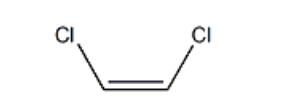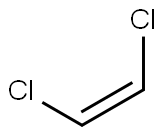What is cis-1,2-dichloroethylene?
cis-1,2-Dichloroethylene (cis-DCE, cis-1,2-C2H2Cl2, CAS registry No. 156-59-2) is a colorless liquid. Its melting point is −80 oC. It is soluble in alcohol, ether, and most other organic solvents. The reaction of cis-DCE and potassium hydroxide can produce chloroacetylene, which is explosive and spontaneously flammable in air. It is highly toxic. So, it is incompatible with moist air or water, bases. When heated to decomposition, it yields hydrogen chloride, carbon monoxide, carbon dioxide.
cis-DCE and other chloroethenes like tetrachloroethene (PCE), trichloroethene (TCE), and vinyl chloride (VC) are extensively used as solvents in different dry cleaning and metal degreasing industries. This utilization of chloroethenes sometimes results in wide range environmental contamination in the nearby anaerobic environmental compartments of ground waters, soils and sediments. This infectivity is a big alarm because of the toxic and carcinogenic traits of chloroethenes. Various studies have shown that under anaerobic conditions, these chloroethene compounds can be reductively dehalogenated by some microbial community followed by dehalorespiration. cis-DCE is frequently found at significant concentrations in groundwater which is contaminated with tetrachloroethylene or trichloroethylene. Under anaerobic conditions, cis-DCE can be biotransformed via reductive dechlorination to ethylene[1].
The degradation of cis-DCE by Dehalococcoides ethenogenes strain 195[2], an anaerobic bacterium that completely dechlorinates PCE to ethene, has been investigated. This bacterium utilizes cis-DCE as a final electron acceptor.
Clostridium sp. Strain DC1 isolated from landfill leachate sediment are capable of degrading cis-DCE[3]. In culture experiments, strain DC1 was shown to degrade cis-DCE during the stationary phase of growth without accumulation of VC and/or ethene. The bacterial growth was not linked to the degradation of cis-DCE and VC.
As another example, the cis-DCE-degrading anaerobic bacterium, Clostridium sp. strain KYT-1[4], was isolated from a sediment sample collected from a landfill site in Nanji-do, Seoul, Korea. The KYT-1 strain is a gram-positive, endospore-forming, motile, rod-shaped anaerobic bacterium, of approximately 2.5-3.0 μm in length. The degradation of cis-DCE is closely related with the growth of the KYT-1 strain, and it was stopped when the growth of the KYT-1 strain became constant. No accumulation of the harmful intermediate, VC, was observed during anaerobic cis-DCE degradation. Strain KYT-1 proved able to degrade a variety of volatile organic compounds, including VC, isomers of DCE (1,1-dichloroethylene, trans-1,2-dichloroethylene, and cis-DCE), trichloroethylene, tetrachloroethylene, 1,2-dichloroethane, 1,1,1-trichloroethane, and 1,1,2-trichloroethane.

Fig 1. Chemical structure formula of cis-1,2-dichloroethylene
References
[1]. Komatsu, T.; Momonoi, K.; Matsuo, T.; Hanaki, K., Biotransformation of cis-1,2-dichloroethylene to ethylene and ethane under anaerobic conditions. Water Science and Technology 1994, 30 (7), 75-84.
[2]. Maymo-Gatell, X.; Chien, Y.; Gossett, J. M.; Zinder, S. H., Isolation of a bacterium that reductively dechlorinates tetrachloroethene to ethene. Science 1997, 276 (5318), 1568-71.
[3]. Hata, J.; Miyata, N.; Kim, E. S.; Takamizawa, K.; Iwahori, K., Anaerobic degradation of cis-1,2-dichloroethylene and vinyl chloride by Clostridium sp strain DC1 isolated from landfill leachate sediment. Journal of Bioscience and Bioengineering 2004, 97 (3), 196-201.
[4]. Kim, E.-S.; Nomura, I.; Hasegawa, Y.; Takamizawa, K., Characterization of a newly isolated cis-1,2-dichloroethylene and aliphatic compound-degrading bacterium, Clostridium sp strain KYT-1. Biotechnology and Bioprocess Engineering 2006, 11 (6), 553-556.

